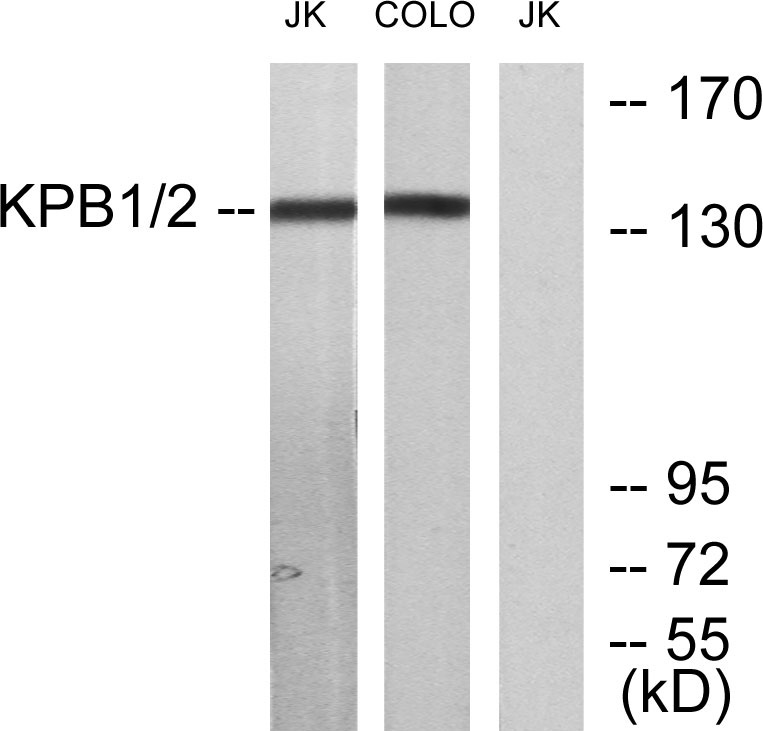PHKA1/2 Polyclonal Antibody
- Catalog No.:YT3700
- Applications:WB;ELISA;IHC
- Reactivity:Human;Mouse;Rat
- Target:
- PHKA1/2
- Fields:
- >>Calcium signaling pathway;>>Insulin signaling pathway;>>Glucagon signaling pathway
- Gene Name:
- PHKA1/PHKA2
- Protein Name:
- Phosphorylase b kinase regulatory subunit alpha skeletal muscle isoform/Phosphorylase b kinase regulatory subunit alpha liver isoform
- Human Gene Id:
- 5255/5256
- Human Swiss Prot No:
- P46020/P46019
- Mouse Gene Id:
- 18679/110094
- Rat Gene Id:
- 64561
- Rat Swiss Prot No:
- Q64649
- Immunogen:
- The antiserum was produced against synthesized peptide derived from human KPB1/2. AA range:31-80
- Specificity:
- PHKA1/2 Polyclonal Antibody detects endogenous levels of PHKA1/2 protein.
- Formulation:
- Liquid in PBS containing 50% glycerol, 0.5% BSA and 0.02% sodium azide.
- Source:
- Polyclonal, Rabbit,IgG
- Dilution:
- WB 1:500-2000;IHC 1:50-300; ELISA 2000-20000
- Purification:
- The antibody was affinity-purified from rabbit antiserum by affinity-chromatography using epitope-specific immunogen.
- Concentration:
- 1 mg/ml
- Storage Stability:
- -15°C to -25°C/1 year(Do not lower than -25°C)
- Other Name:
- PHKA1;PHKA;Phosphorylase b kinase regulatory subunit alpha; skeletal muscle isoform;Phosphorylase kinase alpha M subunit;PHKA2;PHKLA;PYK;Phosphorylase b kinase regulatory subunit alpha, liver isoform;Phosphorylase kinase alpha L sub
- Observed Band(KD):
- 137kD
- Background:
- Phosphorylase kinase is a polymer of 16 subunits, four each of alpha, beta, gamma and delta. The alpha subunit includes the skeletal muscle and hepatic isoforms, and the skeletal muscle isoform is encoded by this gene. The beta subunit is the same in both the muscle and hepatic isoforms, and encoded by one gene. The gamma subunit also includes the skeletal muscle and hepatic isoforms, which are encoded by two different genes. The delta subunit is a calmodulin and can be encoded by three different genes. The gamma subunits contain the active site of the enzyme, whereas the alpha and beta subunits have regulatory functions controlled by phosphorylation. The delta subunit mediates the dependence of the enzyme on calcium concentration. Mutations in this gene cause glycogen storage disease type 9D, also known as X-linked muscle glycogenosis. Alternatively spliced transcript varian
- Function:
- disease:Defects in PHKA1 are the cause of glycogen storage disease type 9D (GSD9D) [MIM:300559]; also known as X-linked muscle glycogenosis. GSD9D is a metabolic disorder characterized by slowly progressive, predominantly distal muscle weakness and atrophy. Clinical features include exercise intolerance with early fatiguability, pain, cramps and occasionally myoglobinuria.,enzyme regulation:By phosphorylation of various serine residues. Allosteric regulation by calcium.,function:Phosphorylase b kinase catalyzes the phosphorylation of serine in certain substrates, including troponin I. The alpha chain may bind calmodulin.,pathway:Glycan biosynthesis; glycogen metabolism.,similarity:Belongs to the phosphorylase b kinase regulatory chain family.,subunit:Polymer of 16 chains, four each of alpha, beta, gamma, and delta. Alpha and beta are regulatory chains, gamma is the catalytic chain, and d
- Subcellular Location:
- Cell membrane ; Lipid-anchor ; Cytoplasmic side .
- Expression:
- Muscle specific. Isoform 1 is predominant in vastus lateralis muscle. Isoform 2 predominates slightly in heart, and it predominates clearly in the other tissues tested.
- June 19-2018
- WESTERN IMMUNOBLOTTING PROTOCOL
- June 19-2018
- IMMUNOHISTOCHEMISTRY-PARAFFIN PROTOCOL
- June 19-2018
- IMMUNOFLUORESCENCE PROTOCOL
- September 08-2020
- FLOW-CYTOMEYRT-PROTOCOL
- May 20-2022
- Cell-Based ELISA│解您多样本WB检测之困扰
- July 13-2018
- CELL-BASED-ELISA-PROTOCOL-FOR-ACETYL-PROTEIN
- July 13-2018
- CELL-BASED-ELISA-PROTOCOL-FOR-PHOSPHO-PROTEIN
- July 13-2018
- Antibody-FAQs
- Products Images

- Immunofluorescence analysis of HeLa cells, using KPB1/2 Antibody. The picture on the right is blocked with the synthesized peptide.

- Western blot analysis of lysates from Jurkat and COLO205 cells, using KPB1/2 Antibody. The lane on the right is blocked with the synthesized peptide.

- Immunohistochemical analysis of paraffin-embedded human uterus. 1, Antibody was diluted at 1:200(4° overnight). 2, Tris-EDTA,pH9.0 was used for antigen retrieval. 3,Secondary antibody was diluted at 1:200(room temperature, 45min).



